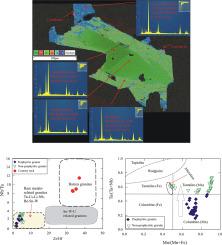Our official English website, www.x-mol.net, welcomes your
feedback! (Note: you will need to create a separate account there.)
Magmatic and hydrothermal evolution of highly-fractionated rare-metal granites at Gabal Nuweibi, Eastern Desert, Egypt
Lithos ( IF 2.9 ) Pub Date : 2021-08-05 , DOI: 10.1016/j.lithos.2021.106405 Hilmy E. Moussa 1 , Paul D. Asimow 2 , Mokhles K. Azer 1 , Moustafa A. Abou El Maaty 1 , Adel I.M. Akarish 1 , Nagy N. Yanni 1 , Heba S. Mubarak 1 , M.J. Wilner 2 , Mustafa A. Elsagheer 1
Lithos ( IF 2.9 ) Pub Date : 2021-08-05 , DOI: 10.1016/j.lithos.2021.106405 Hilmy E. Moussa 1 , Paul D. Asimow 2 , Mokhles K. Azer 1 , Moustafa A. Abou El Maaty 1 , Adel I.M. Akarish 1 , Nagy N. Yanni 1 , Heba S. Mubarak 1 , M.J. Wilner 2 , Mustafa A. Elsagheer 1
Affiliation

|
The Nuweibi intrusion was emplaced during the final tectono-magmatic stage of Arabian-Nubian Shield development (ANS). Two cogenetic phases of intrusion can be recognized in the field: the early phase is represented by porphyritic albite granite and the final phase by non-porphyritic albite granite. Mineralogically, both phases are essentially composed of albite, quartz, and K-feldspars with subordinate muscovite. Accessory minerals include fluorite, zircon, NbTa oxides, cassiterite, beryl, topaz, and garnet. Geochemically, the Nuweibi intrusion consists of extensively fractionated rare-metal granite with low contents of TiO, FeO, CaO, MgO, PO, Sr, and Ba in contrast to elevated concentrations of alkalis, Rb, Nb, Ta, and Hf. Their peraluminous (molar AlO/[CaO + NaO + KO] = 1.06–1.15) and low-P (PO < 0.008 wt%) character identify them as highly fractionated I-type granites. The primary magma of the Nuweibi intrusion was most likely generated by partial melting of the juvenile crust of the ANS. We document numerous lines of evidence that the Nuweibi albite granite was formed by extensive fractional crystallization followed by interaction with magmatically-derived, F-rich hydrothermal solutions. The REE patterns of the Nuweibi albite granite show marked negative Eu anomalies (Eu/Eu = 0.01–0.15) as well as prominent M-type tetrad effects (TE = 1.332–3.536), typically seen in highly differentiated granites and attributed to exchange with hydrothermal fluid. Anomalous ratios of isovalent “twin” elements such as Nb/Ta, Zr/Hf, and Y/Ho likewise indicate exchange with hydrothermal fluid. The primary rare-metal accessory minerals are restricted to the Mn-rich part of the columbite-tantalite series; this manganoan trend is characteristic of highly fractionated granites. Likewise, the presence of wodginite, a Sn-bearing mineral, is a unique fingerprint of highly evolved rare-metal granites. Late-stage hydrothermal overprint of the primary rare-metal mineralization is preserved by rims of fluorcalciomicrolite partly replacing columbite-(Mn) and tantalite-(Mn). Accumulation of residual volatile-rich melt and exsolved fluids in the upper part of the magma chamber produced stockscheider pegmatite, greisen, and quartz veins that cut the peripheries of the Nuweibi intrusion and the surrounding country rocks.
中文翻译:

埃及东部沙漠加巴尔努韦比高分异稀有金属花岗岩的岩浆和热液演化
努韦比侵入发生在阿拉伯-努比亚地盾发育(ANS)的最后构造岩浆阶段。现场可识别出两个同生阶段的侵入岩:早期阶段以斑状钠长石花岗岩为代表,最终阶段以非斑状钠长石花岗岩为代表。从矿物学角度来看,这两个相本质上都是由钠长石、石英和钾长石以及次要的白云母组成。副矿物包括萤石、锆石、铌钽氧化物、锡石、绿柱石、黄玉和石榴石。从地球化学角度来看,努韦比岩体由广泛分异的稀有金属花岗岩组成,其中 TiO、FeO、CaO、MgO、PO、Sr 和 Ba 含量较低,而碱金属、Rb、Nb、Ta 和 Hf 含量较高。它们的过铝质(摩尔 Al2O/[CaO + NaO + KO] = 1.06–1.15)和低磷(PO < 0.008 wt%)特征表明它们是高度分异的 I 型花岗岩。努韦比侵入体的原生岩浆很可能是由 ANS 幼年地壳的部分熔融产生的。我们记录了大量证据,证明努韦比钠长石花岗岩是通过广泛的分异结晶作用,然后与岩浆衍生的富含氟的热液相互作用而形成的。努韦比钠长石花岗岩的 REE 模式显示出明显的负 Eu 异常(Eu/Eu = 0.01–0.15)以及显着的 M 型四分体效应(TE = 1.332–3.536),通常出现在高度分异的花岗岩中,归因于与热液。Nb/Ta、Zr/Hf 和 Y/Ho 等等价“孪生”元素的异常比率同样表明与热液发生交换。主要稀有金属副矿物仅限于铌铁矿-钽铁矿系列的富锰部分;这种锰矿趋势是高度分异花岗岩的特征。同样,硅锰矿(一种含锡矿物)的存在是高度演化的稀有金属花岗岩的独特指纹。原生稀有金属矿化的后期热液叠印被氟钙微晶石的边缘所保留,部分取代了铌铁矿(Mn)和钽铁矿(Mn)。岩浆房上部残留的富含挥发分的熔体和溶出的流体的积累产生了斯托克斯谢德伟晶岩、云英岩和石英脉,这些岩脉切割了努韦比岩体和周围围岩的外围。
更新日期:2021-08-05
中文翻译:

埃及东部沙漠加巴尔努韦比高分异稀有金属花岗岩的岩浆和热液演化
努韦比侵入发生在阿拉伯-努比亚地盾发育(ANS)的最后构造岩浆阶段。现场可识别出两个同生阶段的侵入岩:早期阶段以斑状钠长石花岗岩为代表,最终阶段以非斑状钠长石花岗岩为代表。从矿物学角度来看,这两个相本质上都是由钠长石、石英和钾长石以及次要的白云母组成。副矿物包括萤石、锆石、铌钽氧化物、锡石、绿柱石、黄玉和石榴石。从地球化学角度来看,努韦比岩体由广泛分异的稀有金属花岗岩组成,其中 TiO、FeO、CaO、MgO、PO、Sr 和 Ba 含量较低,而碱金属、Rb、Nb、Ta 和 Hf 含量较高。它们的过铝质(摩尔 Al2O/[CaO + NaO + KO] = 1.06–1.15)和低磷(PO < 0.008 wt%)特征表明它们是高度分异的 I 型花岗岩。努韦比侵入体的原生岩浆很可能是由 ANS 幼年地壳的部分熔融产生的。我们记录了大量证据,证明努韦比钠长石花岗岩是通过广泛的分异结晶作用,然后与岩浆衍生的富含氟的热液相互作用而形成的。努韦比钠长石花岗岩的 REE 模式显示出明显的负 Eu 异常(Eu/Eu = 0.01–0.15)以及显着的 M 型四分体效应(TE = 1.332–3.536),通常出现在高度分异的花岗岩中,归因于与热液。Nb/Ta、Zr/Hf 和 Y/Ho 等等价“孪生”元素的异常比率同样表明与热液发生交换。主要稀有金属副矿物仅限于铌铁矿-钽铁矿系列的富锰部分;这种锰矿趋势是高度分异花岗岩的特征。同样,硅锰矿(一种含锡矿物)的存在是高度演化的稀有金属花岗岩的独特指纹。原生稀有金属矿化的后期热液叠印被氟钙微晶石的边缘所保留,部分取代了铌铁矿(Mn)和钽铁矿(Mn)。岩浆房上部残留的富含挥发分的熔体和溶出的流体的积累产生了斯托克斯谢德伟晶岩、云英岩和石英脉,这些岩脉切割了努韦比岩体和周围围岩的外围。











































 京公网安备 11010802027423号
京公网安备 11010802027423号